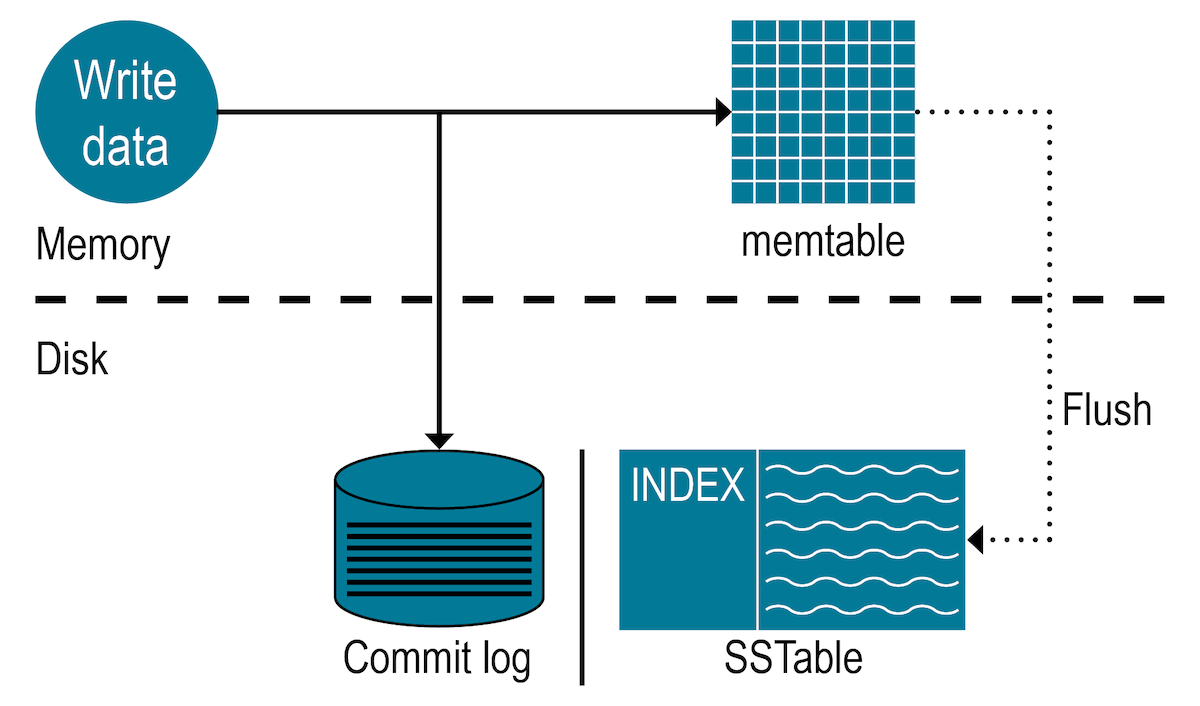Memtable
A data structure that holds data in memory before it’s flushed into disk.
For a write operation we write to memory which is fast compared to persistent storage, eventually, a memtable will surpass a predefined memory threshold and it’ll need to be flushed to disk, while we can define our own write format we can write the memtable in a sorted way to disk as an SSTable (see SSTable below). Once data is written to disk the data becomes immutable (the SSTable cannot be modified), therefore, new writes go to a new memtable and operations like update or delete on existing data in the previous memtable are instead stored in the new memtable.
For a read operation we first check in the current memtable, if the read can’t be fulfilled by the current memtable (maybe the data exists but it’s no longer in memory because it was flushed to disk) then we check recently created SSTables in decreasing creation order until we find the desired record (or we might not find it at all). Because the SSTable is sorted it enables faster reads because we can use binary search to find it in the file.
A memtable can be implemented with a Red-Black Tree, a SkipList, a HashSkipList, a HashLinkList. For tradeoffs on these implementations please check the RocksDB wiki .
Applications
Example: design a Timeseries Database with the following requirements:
- For the current time, write a given value for a given list of labels, a label is a pair
labelKey=labelValuee.g.[method=http, type=POST, statusCode=200] 1(value is1) - The labels can be arbitrary strings
- Reads will be for an arbitrary combination of labels and it’ll cover a range of time (common)
- Reads will be for an arbitrary combination of labels and it’ll cover a point in time (rare)
- Write heavy system
- 99% of the data is never queried after 24h
A memtable fits this problem because it’s a write heavy system (therefore we need fast writes), the common scenario of reads for a range of time would also fit a linked list (either SkipList or HashLinkList), after a memtable is written to disk in a SSTable it enables slower reads for old data which is an acceptable tradeoff because 99% of the data is never queried after 24h.
Let’s define an entry to be a data structure that holds a collection of labels, a single value and a time.
type Entry struct {
// id is the time an entry was created (not threadsafe)
id time.Time
// labels are the labels that identify the entry.
labels map[string]string
// value is the entry value.
value any
// next is an pointer to the next Entry.
next *Entry
}
// example:
entry := &Entry{
id: time.Now(),
labels: map[string]string{
"method": "http",
"type": "POST",
"statusCode": "200",
},
value: 1,
}
Our memtable is a collection of entries stored in a linked list, the memtable has a pointer to the head and the tail
of the linked list. index is explained later in this article.
type Memtable struct {
// head is the head of the linked list.
head *Entry
// tail is the head of the linked list.
tail *Entry
// index is a reverse index of a label to an entry.
index map[string][]*Entry
}
On write a new entry is added at the tail of the memtable linked list.
func (m *Memtable) Write(labels map[string]string, value any) {
e := &Entry{
id: time.Now(),
labels: labels,
value: value,
}
// process entry
for k, v := range labels {
key := m.encode(k, v) // encode creates a unique key in the HashMap
m.index[key] = append(m.index[key], e)
}
m.tail.next = e
m.tail = m.tail.next
}
To find entries by label(s) we can iterate the linked list starting from head until tail collecting
entries that match our labels in O(n) where n is the size of the linked list. To improve the performance
of a query we can use an index that maps a label to the locations of entries, this speeds up the find operation
by O(k) where k is the max number of entries mapped to a label, the tradeoff is space
and the fact that we have to update the index on every write.
With the above we got values for single labels, for multiple labels we combine the results by doing an intersection.
func (m *Memtable) Read(labels map[string]string) []any {
// read temporary results for every label
entriesGroup := make([][]*Entry, 0)
for k, v := range labels {
key := m.encode(k, v)
entriesGroup = append(entriesGroup, m.index[key])
}
// intersect
if len(entriesGroup) == 0 {
return make([]any, 0)
}
intersectedEntries := entriesGroup[0]
for i := 1; i < len(entriesGroup); i += 1 {
intersectedEntries = intersect(intersectedEntries, entriesGroup[i])
}
out := make([]any, 0)
for _, entry := range intersectedEntries {
out = append(out, entry.value)
}
return out
}
SSTable
An immutable data structure that stores a large number of key:value pairs sorted by key
Advantages over simple hash indexes
- Merging SSTables is similar to doing a merge sort
- To find if a key exists we don’t need an index of all the keys in memory, instead we can keep an index for every few kilobytes and then perform a scan (sparse index)
- range queries can be compressed before writing to disk, the sparse index would only need to find the starting position of the compressed segment


